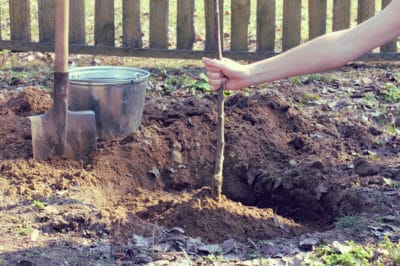The Best Time and Place for Planting Cherry Trees
Cherry trees and most other fruit trees are best planted in the fall or early spring when the soil is cool and damp and the sapling tree is dormant.
However, cherry trees do not tolerate soggy soil conditions, so don’t plant them when the soil is saturated with water from recent rains or heavy rains are expected in the near future.
Locate your new trees in a spot with good soil drainage. You can investigate how well your soil drains by digging a 1 cubic foot (28 liter) hole, filling it with water, and timing how long it takes for the water to drain out.
If water drains out of the hole at a rate of 1 to 4 inches (2.5 to 10.2cm) per hour, drainage is good. If it takes a longer or shorter time for water to drain, consider a different spot for planting your trees or amend the soil to achieve better drainage.
Where to Get a Cherry Tree to Plant
You may think you can plant a cherry tree by burying a cherry pit in the soil, but this is unlikely to produce a good quality fruit tree.
Instead, start your cherry trees from bare root stock or a young sapling purchased from a plant nursery. It is best to transplant the tree into your garden when it is dormant and does not have any leaves in fall, winter, or early spring.
Bare root trees are young trees which have been dug up while dormant, leaving the roots bare. The tree’s roots are then kept in a moist medium such as sawdust or peat moss and wrapped in burlap to protect them until transplanting time.
Some of the most popular varieties of sweet cherry are:
- Bing: Large, juicy, dark red fruit.
- Chelan: Ripens early, with sweet, very dark red fruit.
- Rainier: Sweet, large yellow fruit with a touch of red inside and out.
- Lapins: Large, dark red, with a short, later harvest date.
Bare root trees are readily available at plant nurseries in fall, winter, and early spring.
Planting More than One Tree for Pollination
The flowers of cherry trees are usually self-fertile, meaning they contain both male and female reproductive parts and can self-pollinate. However, planting two or more compatible varieties of cherry near one another leads to better pollination and fruit production, even with self-fertile trees.
When you buy your bare root trees, check the variety and make sure you are buying trees which can pollinate each other. This will assure you the best possible harvest of fruit.
